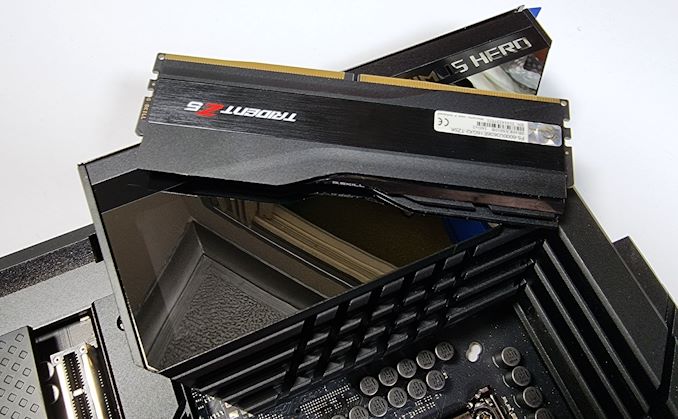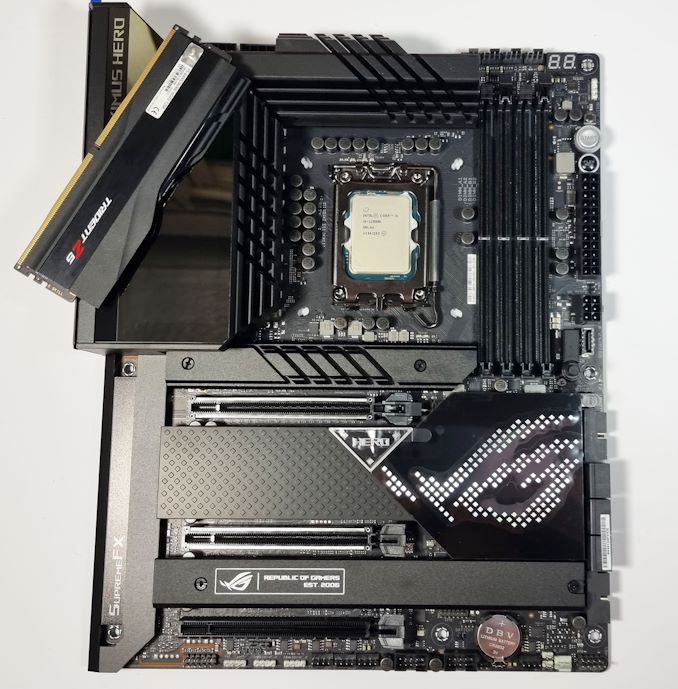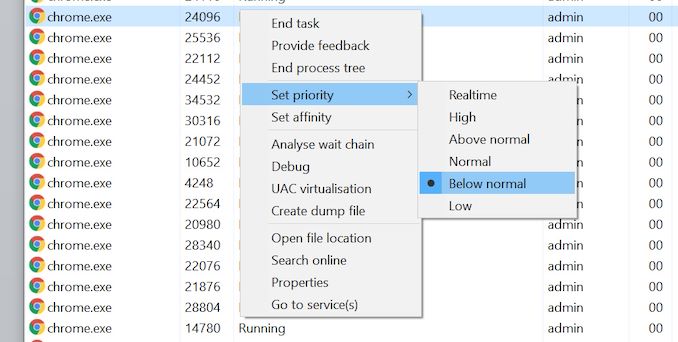Intel Alder Lake DDR5 Memory Scaling Analysis With G.Skill Trident Z5
by Gavin Bonshor on December 23, 2021 9:00 AM EST
One of the most agonizing elements of Intel's launch of its latest 12th generation Alder Lake desktop processors is its support of both DDR5 and DDR4 memory. Motherboards are either one or the other, while we wait for DDR5 to take hold in the market. While DDR4 memory isn't new to us, DDR5 memory is, and as a result, we've been reporting on the release of DDR5 since last year. Now that DDR5 is here, albeit difficult to obtain, we know from our Core i9-12900K review that DDR5 performs better at baseline settings when compared to DDR4. To investigate the scalability of DDR5 on Alder Lake, we have used a premium kit of DDR5 memory from G.Skill, the Trident Z5 DDR5-6000. We test the G.Skill Trident Z5 kit from DDR5-4800 to DDR5-6400 at CL36 and DDR5-4800 with as tight timings as we could to see if latency also plays a role in enhancing the performance.
DDR5 Memory: Scaling, Pricing, Availability
In our launch day review and analysis of Intel's latest Core i9-12900K, we tested many variables that could impact performance on the new platform. This includes the performance variation when using Windows 11 versus Windows 10, performance with both DDR5 and DDR4 at official speeds, and the impact that both the new hybrid Performance and Efficient cores.
With all of the different variables in that review, the purpose of this article is to evaluate and analyze the impact that DDR5 memory frequency plays on performance. While in our past memory scaling articles, we've typically stuck with just focusing on the effects of frequency, but this time we wanted to see how tighter latencies can have an impact on overall performance as well.

ASUS ROG Maximus Z690 Hero motherboard with G.Skill Trident Z5 DDR5-6000 memory
Touching on the pricing and availability of DDR5 memory at the time of writing, the TLDR is that it's currently hard to find any in stock, and when it is in stock, it costs a lot. With a massive global chip shortage that many put down to the Coronavirus Pandemic, the drought has bumped prices above MSRP on many components. Interestingly enough, it's not the DDR5 itself causing the shortage, but the power management controllers that DDR5 uses per module to get higher bandwidth are in short supply. As a result, the increased cost can be likened to a sort of early adopters fee, where users wanting the latest and greatest will have to pay through the nose to own it.
Another variable to consider with DDR5 memory is that a 32GB (2x16) kit of G.Skill Ripjaw DDR5-5200 can be found at retailer MemoryC for $390. In contrast, a more premium and faster kit such as G.Skill Trident Z5 DDR5-6000 has a price tag of $508, an increase of around 30%. One of the things to consider is that a price increase isn't linear to the performance increase, and that goes for pretty much every component from memory, graphics cards, and even processors. The more premium a product, the more it costs.
Enabling X.M.P 3.0: It's Technically Overclocking
In March 2021, we reported that Intel effectively discontinued its 'Performance Tuning Protection Plan.' This was essentially an extended warranty for users planning to overclock Intel's processors, which could be purchased at an additional cost. One of the main benefits of this was that if users somehow damaged the silicon with higher than typical voltages (CPU VCore and Memory related voltages), users could effectively RMA the processors back to Intel on a like for like replacement basis. Intel stated that very few people took advantage of the plan to continue it.
One of the variables to note when running Intel's Xtreme Memory Profiles (X.M.P 3.0) on DDR5 memory is that Intel classes this as overclocking. That means when RMA'ing a faulty processor, running the CPU at stock settings but enabling, an X.M.P 3.0 memory profile at DDR5-6000 CL36 is something they consider as an overclock. This could inherently void the warranty of the CPU. All processor manufacturers adhere to JEDEC specifications with their recommended memory settings to use with any given processor, such as DDR4-3200 for its 11th generation (Rocket Lake) and DDR5-4800/DDR4-3200 for its 12th generation (Alder Lake) processors.
When it comes to overclocking DDR5 memory on the ASUS ROG Maximus Z690 Hero, we did all of our testing with Intel's Memory Gear at the 1:2 ratio. We did test the 1:1 and 1:4 ratio but without any great success. When enabling X.M.P on the G.Skill kit, it automatically sets the 1:2 ratio, with the memory controller running at half the speed of the memory kit.
Issues Within Windows 10: Priority and Core Scheduling
As we highlighted in our review of the Intel Core i9-12900K processor, in certain software environments there can be unexpected performance behavior. When a thread starts, the operating system (Windows 10) will assign a task to a specific core. As the P-Cores (performance) and E-Cores (efficiency) on the hybrid Alder Lake design are at different performances and efficiencies, it is up to the scheduler to make sure the right task is on the right core. Intel's intended use case is that the in-focus software gets priority, and everything else is moved to background tasks. However, on Windows 10, there is an additional caveat - any software set to below normal (or lower) priority will also be considered background, and be placed on the E-cores, even if it is in focus. Some high-performance software sets itself as below normal priority in order to keep the system running it responsive, so there's a clash of ideology between the two.

Various solutions to this exist. Intel stated to us that users could either run dual monitors or change the Windows Power Plan to High Performance. To investigate the issue during testing, all of our testing in this article was done with the Windows Power Plan set to High-Performance (as I do for motherboard reviews) and running the tests with the High-Performance Power Plan active.
In addition to this, I also used a third-party scheduler, the Process Lasso software, to check for performance variations. I can safely and confidently say that there was around a 0.5% margin of variance between using the High-Performance Power Plan and setting the affinities and priorities to high using the Process Lasso software.
It should also be noted that users running Windows 11 shouldn't experience any of these issues. When set correctly, we saw no difference between Windows 10 and Windows 11 in our original Core i9-12900K review, and so to keep things consistent with our previous testing for now, we're sticking with Windows 10 with our fix applied.
Test Bed, Setup, and Hardware
As this article focuses on how well DDR5 memory scales, we have used a premium Z690 motherboard, the ASUS ROG Maximus Z690 Hero, and a premium ASUS ROG Ryujin II 360 mm AIO CPU cooler. In terms of settings, we've left the Intel Core i9-12900K at default variables as per the firmware, with the only changes made regarding the memory settings.
| DDR5 Memory Scaling Test Setup (Alder Lake) | |||
| Processor | Intel Core i9-12900K, 125 W, $589 8+8 Cores, 24 Threads 3.2 GHz (5.2 GHz P-Core Turbo) |
||
| Motherboard | ASUS ROG Maximus Z690 Hero (BIOS 0803) | ||
| Cooling | ASUS ROG Ryujin II 360 360mm AIO | ||
| Power Supply | Corsair HX850 80Plus Platinum 850 W | ||
| Memory | G.Skill Trident Z5 2 x 16 GB DDR5-6000 CL 36-36-36-76 (XMP) |
||
| Video Card | MSI GTX 1080 (1178/1279 Boost) | ||
| Hard Drive | Crucial MX300 1TB | ||
| Case | Open Benchtable BC1.1 (Silver) | ||
| Operating System | Windows 10 Pro 64-bit: Build 21H2 | ||
For the operating system, we've used the most widely available and latest build of Windows 10 64-bit (21H2) with all of the current updates at the time of testing. (For those wondering about our selection of GPU, the truth is that all our editors are in different locations in the world and we do not have a singular pool of resources. This is Gavin's regular testing GPU until we can get a replacement; which in this current climate is unlikely. - Ian)
| DDR5 Memory Frequencies/Latencies Tested | |||
| Memory | Frequency/Timings | Memory IC | |
| G.Skill Trident Z5 (2 x 16 GB) | DDR5-4800 CL 32-32-32-72 DDR5-4800 CL 36-36-36-76 DDR5-5000 CL 36-36-36-76 DDR5-5200 CL 36-36-36-76 DDR5-5400 CL 36-36-36-76 DDR5-5600 CL 36-36-36-76 DDR5-5800 CL 36-36-36-76 DDR5-6000 CL 36-36-36-76 DDR5-6200 CL 36-36-36-76 DDR5-6400 CL 36-36-36-76 |
Samsung | |
Above are all of the frequencies and latencies we've tested in this article. For scaling, we selected the G.Skill Trident Z5 memory kit as it had the best overclocking ability from all of the DDR5 kits we received at launch. Out of the box it was rated the highest for frequency, and we pushed it even further. The G.Skill Trident Z5 memory was tested from DDR5-4800 CL36 up to and including DDR5-6400 CL36, but also a special case of DDR5-4800 CL32 for lower CAS latencies. Details on our overclocking exploits are later in the review.
Read on for more information about G.Skill's Trident Z5 DDR5-6000, as well as our analysis on the scalability of DDR5 memory on Intel's Alder Lake. In this article, we cover the following:
- 1. Overview and Test Setup (this page)
- 2. A Closer Look at the G.Skill Trident Z5 DDR5-6000 CL36
- 3. CPU Performance
- 4. Gaming Performance: Low Resolution
- 5. Gaming Performance: High Resolution
- 6. Conclusion










82 Comments
View All Comments
Slash3 - Thursday, December 23, 2021 - link
Process Lasso, not Project Lasso. ;)(This has happened in previous articles, too)
futrtrubl - Thursday, December 23, 2021 - link
Interesting that 5800 seems consistently better in these tests. I wonder if there is a timing/ratio related reason for that.evilspoons - Thursday, December 23, 2021 - link
Consistently worse, no? The times are longer and the frame rates are lower.meacupla - Thursday, December 23, 2021 - link
I would like to see IGPU performance with the various speeds.Now, I know the IGPU on desktop alder lake is poor, but AMD 6000 APUs are right around the corner, and I would like to see how well IGPU scales on DDR5 in general.
gagegfg - Thursday, December 23, 2021 - link
There is almost no difference. UHD 770 has very poor performance and does not scale as well with higher bandwidth as it does on AMD's IGPU.meacupla - Thursday, December 23, 2021 - link
well that's a shameWrs - Thursday, December 23, 2021 - link
Amd's iGPU hardly scales on DDR4 - can't really tell it apart from CPU scaling or even run to run variance.praeses - Thursday, December 23, 2021 - link
They typically see a 10% performance increase going from 3200-4000 with similar timings, the delta grows if you're comparing loose 3200 and tight 4000 timings.Samus - Thursday, December 23, 2021 - link
I suspect the memory bus is the limiting factor with AMD iGPU's as all of their recent memory architectures (going back to at least Polaris) were 128-bit+ DDR5 or HBM.The rare, NERFed examples paint a clearer picture: the only Polaris desktop GPU on 64-bit was the R7 435 (I think) and it had DDR3 at 2GHz. It was slower than most APU's at the time and remains one of those recent desktop cards that shouldn't have ever existed for desktop PC's. There just aren't many 64-bit cards, especially on DDR3, that return reasonable gains over integrated graphics; both are going to be so underperforming neither will play games reasonably well.
TheinsanegamerN - Tuesday, December 28, 2021 - link
I think tha tmostly comes down to AMD's memory controller then, considering those APUs are running on dual channel 128 bit memory busses.DDR4 just isnt that good for GPUs, easily demonstrated with the GT 1030 which, depsite its lack of power, was severely hamstrung on DDR4 VS 5.